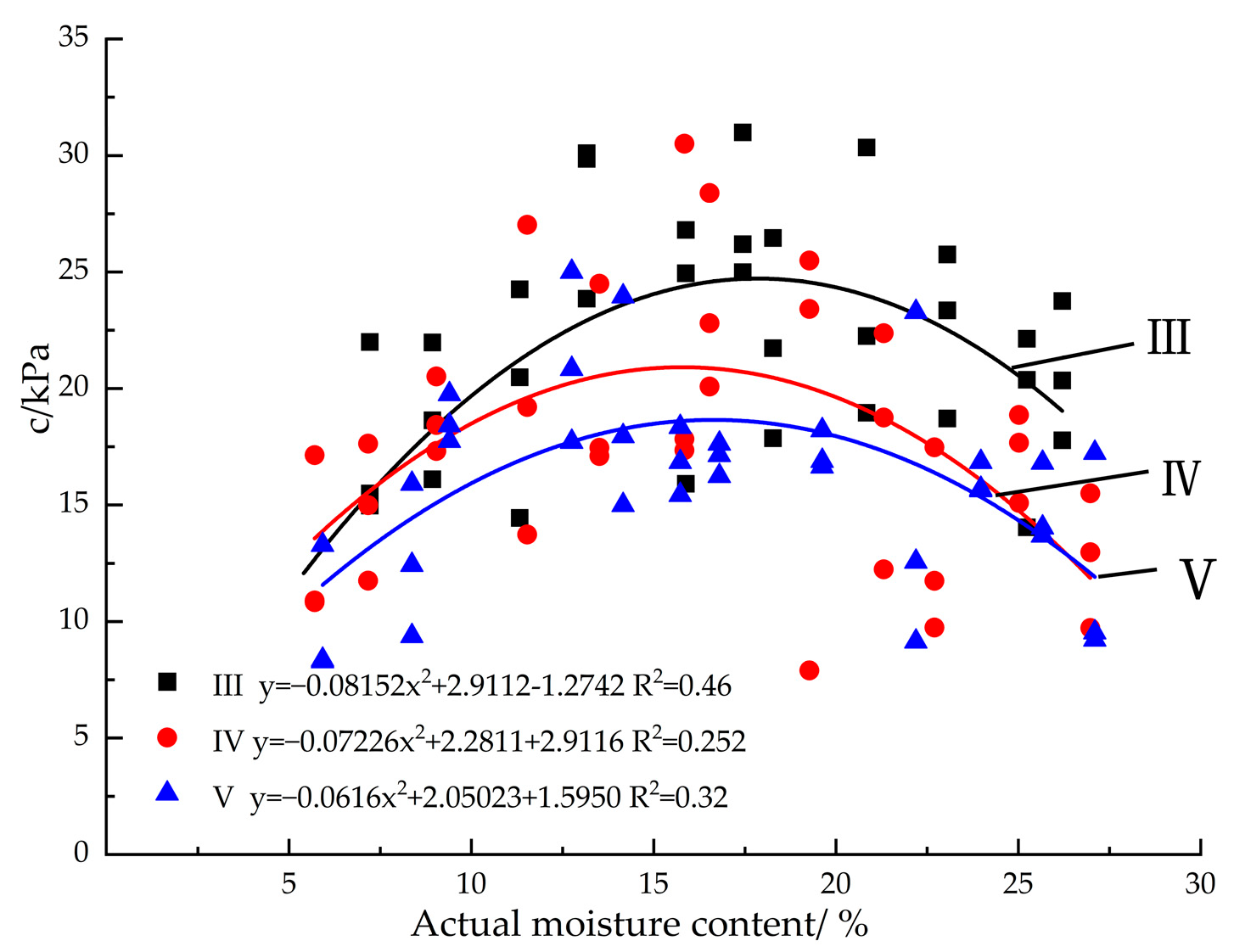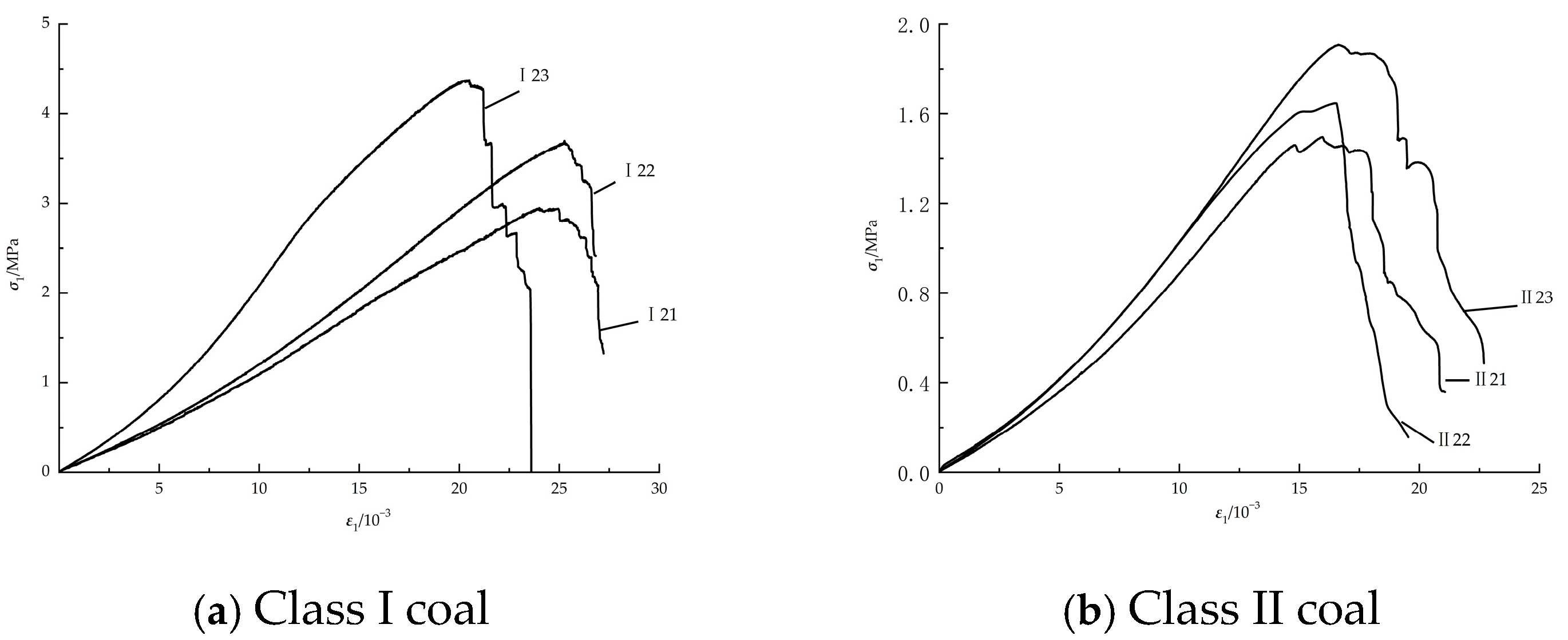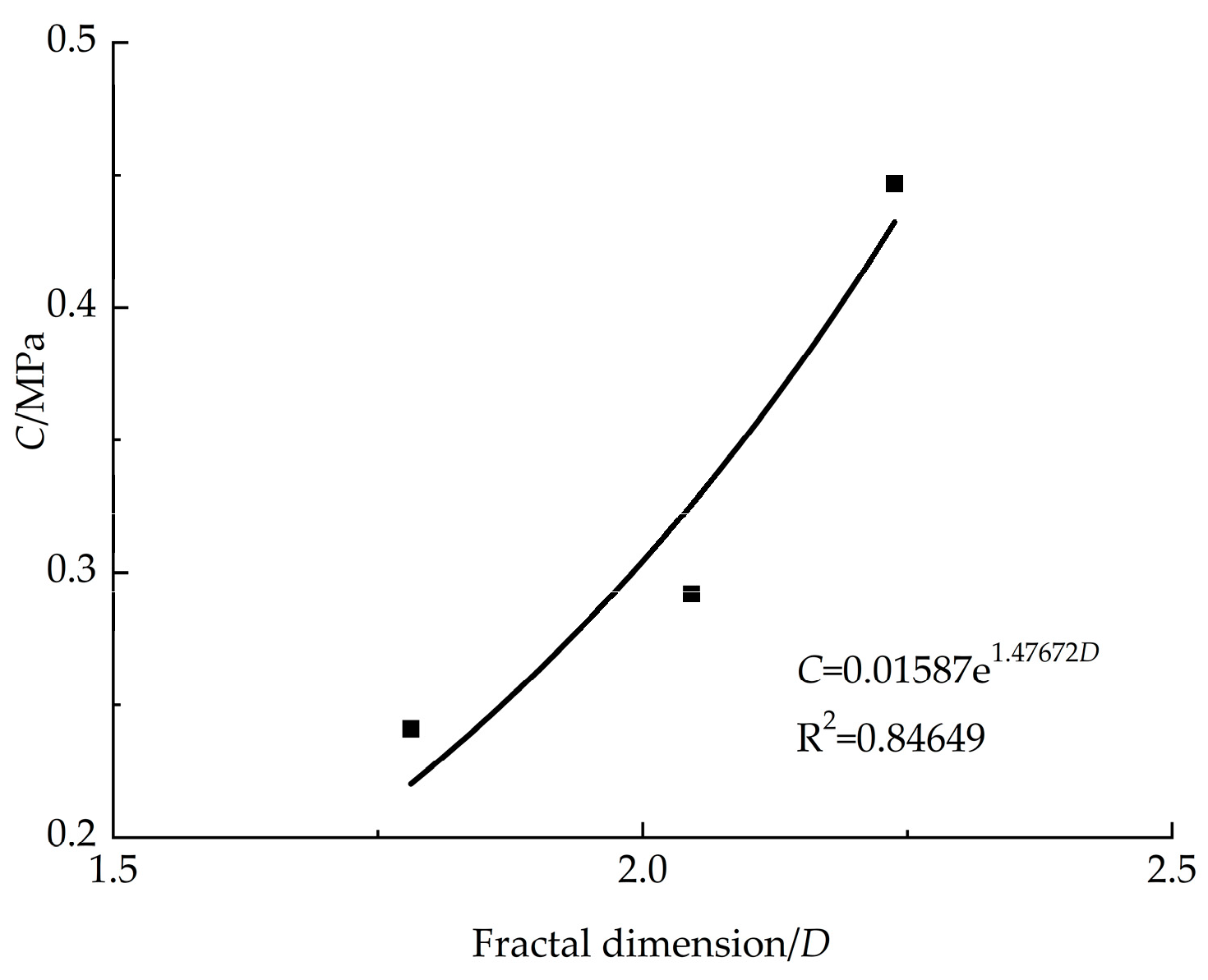6.1. Uniaxial Compression Test
In this study, we selected representative samples (III 1, IV 1, and V 2) of three types of coal samples. The appropriate amount of coal sample was placed in a standard mold, a small amount of water was added, and a molding pressure of 200 kN was applied for 30 min. The dimensions of the produced samples were
Φ50 mm × 100 mm. The uniaxial compression stress–strain curves of the coal specimens are shown in
Figure 8. The results of the uniaxial compression experiment are presented in
Table 9.
As shown in
Table 9, the strengths of the Class III–V coal were lower. In order to explore whether the strength characteristics of the type of coal specimen were related to the firmness coefficient
f, samples of raw Class I and II coal were collected from the same coal seam. The samples were ground, and samples III 1, IV 1, and V 2 were prepared using the same type of compression process used to prepare the molded coal specimens. It is best to regard the homogeneity of the coal specimen as isotropic. Therefore, specimens of the Class I and II coal for each level of coal were prepared and numbered I 21, I 22, I 23, II 21, II 22, II 23, III 21, III 22, III 23, IV 21, IV 22, IV 23, V 21, and V 22. The experimental results are presented in
Table 5, and the stress–strain curve is shown in
Figure 8.
As can be seen from
Figure 8, the lower the strength of the coal type is, the slower the stress–strain curve decreases after the peak. For the stress–strain curve of the Class I coal, after the peak, there is a more obvious cliff-type stress reduction. It can also be seen that the types of coal specimens also reflect the elasticity of the original coal specimens. Class III coal has the lowest strength, and the decrease after the peak of the curve is the gentlest. It can be seen that its plasticity is larger, reflecting the characteristics of soft coal.
Table 1 and
Table 9 can be used to obtain the uniaxial compressive strength
σ1 of the coal specimens and the six grades of the Class III–V coal samples by utilizing the firmness coefficient
f and the relationship between the fractal dimension
D. The corresponding curve is shown in
Figure 9.
Figure 9 shows that compared with the Class I and II coals, the Class III–V coal specimens have better correlations between the uniaxial compressive strength
σ1, firmness coefficient
f, and fractal dimension
D. With increasing fractal dimension
D, the coefficient of firmness
f decreases, and the proportion of the coal sample composed of fine particles gradually increases. The specific gravity of the fine particles in the coal samples gradually increases. The strengths of the coal samples with the same particle size gradation differ greatly, and the uniaxial strength
σ1 of the coal samples increases with increasing fractal dimension
D. The larger the specific gravity of the fine particles, the greater the strength.
As can be seen from
Table 5, the uniaxial compressive strength of the coal samples is not only related to the particle size gradation but also to the firmness coefficient
f, and compared with the fractal dimension
D, the firmness coefficient is the main factor affecting the strength of the type of coal. Although it can be seen from
Figure 9a that for the Class III–V coal, the uniaxial compressive strength
σ1 increases with increasing fractal dimension
D, while its firmness coefficient
f gradually decreases. The decrease in the coefficient of firmness
f with increasing
D value is due to an increase in the degree of tectonic fragmentation: the higher the
D value, the higher the degree of fragmentation, the more microcracks are produced, and the fewer intact coal bridges there are. This reduces the overall compressive strength and hence
f. According to
Table 9, compared with the Class I and II coal, the firmness coefficients f of the Class III–V coal are lower, more similar in value, exhibit smaller amplitude, and have a limited impact on the uniaxial compressive strength. Thus, the effect of the fractal dimension
D on the uniaxial compressive strength
σ1 plays a major role.
By comparing the Class I and II coals in
Figure 9a, it was concluded that the uniaxial compressive strengths
σ1 of coal samples I 21, II 21, and III (the Class I and II coals were also extracted from anthracite in the same seam as the Class III–V coals, so the influences of the coefficient of cohesion and internal friction were not taken into account), which had the same sub-dimensions as that of 1.781, were larger than that of the Class II coal under the condition of different sub-dimensions
D, and the sub-dimension
D increased under different conditions. The increase in the uniaxial compressive strength
σ1 with increasing firmness coefficient f is greater than that of the uniaxial compressive strength
σ1 under different fractal dimension numbers (
D), and the uniaxial compressive strength of the Class I coal with dimension number 1.781 is higher than that of the Class II coal with dimension number 2.238. Therefore, it is believed that when the coefficient of adhesion and internal friction are not considered, the primary factor affecting the uniaxial compressive strength of the types of coal is the firmness coefficient, followed by the particle size grading.
6.2. Triaxial Compression Test
The triaxial compression experiments were conducted on the same selected representative coal specimens (III 1, IV 1, and V 2), and the same preparation process was utilized to produce 15 standard coal samples with dimensions of Φ50 mm × 100 mm. These samples were numbered III 24, III 25, III 26, III 27, III 28, IV 24, IV 25, IV 26, IV 27, IV 28, V 23, V 24, V 25, V 26, and V 27. The triaxial compression test was conducted to determine the mechanical parameters. The experimental results are presented in
Table 10, and the triaxial compression stress–strain curves of the coal specimens are shown in
Figure 10.
Due to the low uniaxial compressive strength of the types of coal, we selected five peripheral pressure conditions (0.2, 0.4, 0.6, 0.8, and 1 MPa) for use in the experiment. Under all of the peripheral pressure conditions, the Class III–V coal specimens’ strengths increased sequentially. The final specimen did not exhibit a significant stress drop on the soil triaxial compression curve, which was similar to the triaxial compression experiments conducted to obtain the cohesion
C and the fractal dimension of the types of coal specimens. The relationship between
D and C is shown in
Figure 11.
As can be seen from
Figure 11, the cohesive forces of the types of coal specimens exhibit a certain correlation with the number of sub-dimensions, and the cohesive force
C is positively exponentially correlated with the fractal dimension
D, with a correlation regression coefficient of 0.8465. The regression equation is as follows:
The correlation between the cohesion
C and the fractal dimension
D of the types of coal samples is better, while the correlation between the cohesion
C and the fractal dimension
D of the bulk of the original coal samples is poorer for two reasons. The cohesion is mainly related to the inter-particle adhesion and gradation; the three types of coals were collected from the same seam, and the degree of metamorphism of the anthracite was the same. Thus, depending on the consistency of the adhesion of the coal samples, under the larger molding pressure, the particles bonded together, resulting in better homogeneity and greater compactness compared with the bulk particles under reasonable moisture conditions, which helped increase the bonding between the particles. For the coal samples with more fine particles in the pulverized coal prepared from the types of coal samples with the smallest porosity [
23], the total number of pores was the greatest, the pores between the coarse particles were filled with fine particles, and the sample was more tightly compacted. According to
Table 3, it was concluded that the V 2 samples had good grading, and therefore, their cohesion was the greatest.
As can be seen from
Table 6, the correlation between the internal friction angle
φ of the coal specimen and the fractal dimension
D is poor. We believe that the internal friction angle of the coal specimen is mainly related to the friction coefficient between the particles and the contact area. (1) The f-values of the Class III–V coals are relatively low. During the compression process, the internal particles are under the peripheral pressure and the action of friction [
24]. The Protodyakonov’s coefficients for the investigated Class III–V coal samples were all below 0.4. Notably, Class III and IV coals contained a higher proportion of coarse particles than Class V coal. During the compaction process, more pronounced particle breakage occurred; this altered the internal particle size distribution and modified the interparticle contact areas. (2) The Class III–V coal samples are high metamorphic anthracite, so when the friction coefficient is the same, according to
Table 3, the gradation of the Class V coal is the best. In the molding process, the internal structures of the Class III and IV coal are denser, and the greater the content of fine particles is, the smaller the inter-particle contact area is [
25], so the angle of friction of the Class V coal is smaller. As can be seen from
Table 6, the dispersion coefficient of the value of the internal friction angle of the coal type is 0.018. It can be concluded that the correlation between the fractal dimension and the internal friction angle is not obvious; the internal friction angle is the embodiment of the friction performance of the particles [
26], which is mainly related to their inter-particle contact area and the coefficient of friction. During the high-pressure molding of the coal samples, some of the particles experienced secondary fragmentation; therefore, the correlation between the internal friction angle of the coal-type specimens
φ and the fractal dimension
D is not strong.



















